A New Military Hierarchy of Needs Model
Abstract
1. Introduction
1.1. Theoretical Background
1.2. The Military Hierarchy and Its Components
1.3. Civil–Military Interaction
1.4. The Research Agenda
2. Materials and Methods
Sample
3. Analysis and Coding
3.1. Open Coding
3.2. Axial Coding
3.3. Selective Coding
4. Results
Codes
5. Discussion
6. Limitations
7. Publication Declaration
Author Contributions
Funding
Institutional Review Board Statement
Informed Consent Statement
Data Availability Statement
Conflicts of Interest
References
- Adler, Amy B., and Carl Andrew Castro. 2013. An occupational mental health model for the military. Military Behavioral Health 1: 41–45. [Google Scholar] [CrossRef]
- ADP 6–22. 2019. Army Leadership and the Profession. U.S. Army. Available online: www.usacac.army.mil (accessed on 19 October 2019).
- Baker, Todd A. 1990. Scale Development for Enlistment Motivation Measures. Alexandria: Army Research Institute for the Behavioral and Social Sciences. [Google Scholar]
- Barbour, Rosaline, and Jenny Kitzinger, eds. 1999. Developing Focus Group Research: Politics, Theory, and Practice. London: Sage. [Google Scholar]
- Bernard, H. Russell, Amber Wutich, and Gery W. Ryan. 2010. Analyzing Qualitative Data: Systematic Approaches. Thousand Oaks: Sage Publications. [Google Scholar]
- Boesel, David P., and John A. Richards. 1983. Enlistment Motivation in the All-Volunteer Force Environment: A Review of Major Surveys. Fort Belvoir: Defense Technical Information Center. [Google Scholar]
- Bryant, Antony. 2017. Grounded Theory and Grounded Theorizing: Pragmatism in Research Practice. New York: Oxford University Press. [Google Scholar]
- Burke, Ryan P. 2018. Command and Control: Challenging Fallacies of the ‘Military Model’ in Research and Practice. International Journal of Mass Emergencies & Disasters 36: 149–78. [Google Scholar]
- Cavaleiro, Sandra Veigas Campaniço, Catarina Gomes, and Lopes Miguel Pereira. 2022. Nontechnical Skills. Military Learning 6: 71–84. [Google Scholar]
- Chamberlain, Kerry. 1999. Using grounded theory in health psychology. In Qualitative Health Psychology: Theories and Methods. London: Sage, pp. 183–201. [Google Scholar]
- Chang, Ya-Wen, and Sigmund Hsiao. 2006. Quality of Life: Scaling with Maslow’s Need Hierarchy. Gerontology 52: 376. [Google Scholar] [CrossRef]
- Charmaz, Kathy. 2008. Grounded Theory. In Qualitative Psychology. A Practical Guide to Research Methods. Edited by Jonathan A. Smith. London: Sage, pp. 81–110. [Google Scholar]
- Chen, Kuan-Jung, Chia-Chen Yang, and Hui-Hsun Chiang. 2018. Model of coping strategies, resilience, psychological well-being, and perceived health among military personnel. Journal of Medical Sciences 38: 73. [Google Scholar]
- Corbin, Juliet, and Anselm Strauss. 2008. Basics of Qualitative Research: Techniques and Procedures for Developing Grounded Theory, 3rd ed. Los Angeles: Sage Publications. [Google Scholar]
- Egnell, Robert, Petter Hojem, and Hannes Berts. 2014. Gender, Military Effectiveness, and Organizational Change: The Swedish Model. Berlin: Springer. [Google Scholar]
- Fassinger, Ruth E. 2005. Paradigms, praxis, problems, and promise: Grounded theory in counseling psychology research. Journal of Counseling Psychology 52: 156–66. [Google Scholar] [CrossRef]
- Filosa, Lorenzo, Gianluca Cepale, Enrico Perinelli, Luigi Cinque, Alessandra Coscarelli, and Guido Alessandri. 2021. The Military Academic Motivation Scale (MAMS): A new scale to assess motivation among military cadets from a self-determination theory perspective. European Journal of Psychological Assessment 37: 193–207. [Google Scholar] [CrossRef]
- Flick, Uwe. 2009. An Introduction in Qualitative Research, 4th ed. Thousand Oaks: Sage Publications. [Google Scholar]
- Gawel, Joseph E. 1996. Herzberg’s theory of motivation and Maslow’s hierarchy of needs. Practical Assessment, Research, and Evaluation 5: 11. [Google Scholar]
- Ghatak, Sanchita, and Surabhi Singh. 2019. Examining Maslow’s Hierarchy Need Theory in the Social Media Adoption. FIIB Business Review 8: 292–302. [Google Scholar] [CrossRef]
- Gjørv, Gunhild Hoogensen. 2016. Understanding Civil-Military Interaction: Lessons Learned from the Norwegian Model. London: Routledge. [Google Scholar]
- Glaser, Barney G. 2014. Choosing grounded theory. The Grounded Theory Review 13: 3–19. [Google Scholar]
- Griffin, Ricky W., and Gregory Moorhead. 2014. Managing People in Organization. Nashville: South-Western. [Google Scholar]
- Griffith, James. 2009. Being a Reserve soldier: A matter of social identity. Armed Forces and Society 36: 38–64. [Google Scholar] [CrossRef]
- Grosswirth Kachtan, Dana, and Eve Binks. 2021. Soldiers’ Perceptions and Expectations of Converting Military Capital—The Cases of Israeli and British Militaries. Sociological Inquiry 91: 849–76. [Google Scholar] [CrossRef]
- Harig, Christoph, Nicole Jenne, and Chiara Ruffa. 2021. Operational experiences, military role conceptions, and their influence on civil-military relations. European Journal of International Security 7: 1–17. [Google Scholar] [CrossRef]
- Ibrahim, Nora, Noor Azmi Mohd Zainol, Rayyan Cheong Tian Ming, Jessica Ong Hai Liaw, and Safar Yaacob. 2021. Motivation affect the organizational commitment of royal Malay regiment personnel. Turkish Journal of Computer and Mathematics Education 12: 5519–27. [Google Scholar]
- Johnson, Robert J., and Howard B. Kaplan. 1991. Psychosocial predictors of enlistment in the all-voluntary armed forces: A life-event-history analysis. Youth and Society 22: 291–317. [Google Scholar] [CrossRef]
- Khan, Shahid N. 2014. Qualitative research method: Grounded Theory. International Journal of Business and Management 9: 224–33. [Google Scholar] [CrossRef]
- Krebs, Ronald R., and Robert Ralston. 2020. Patriotism or Paychecks: Who Believes What About Why Soldiers Serve. Armed Forces and Society 48: 0095327X20917166. [Google Scholar] [CrossRef]
- Krueger, Richard A. 1988. Focus Groups: A Practical Guide for Applied Research. Newbury Park: Sage. [Google Scholar]
- Krueger, Richard A. 1993. Quality control in focus group research. In Successful Focus Groups: Advancing the State of the Art. Edited by David L. Morgan. Newcastle upon Tyne: Sage, pp. 65–85. [Google Scholar]
- Lieberman, Bruce S., and Elisabeth S. Vrba. 1995. Hierarchy theory, selection, and sorting. BioScience 45: 394–99. [Google Scholar] [CrossRef]
- Lu, Yiwey, Ruopeng Yang, Xuping Jiang, Dan Zhou, Changseng Yin, and Zizhuo Li. 2021. MRE: A Military Relation Extraction Model Based on BiGRU and Multi-Head Attention. Symmetry 13: 1742. [Google Scholar] [CrossRef]
- Lyubomirsky, Sonja. 2009. The How of Happiness: A New Approach to Getting the Life You Want. London: Penguin Group, pp. 34–56. ISBN 9780143114956. [Google Scholar]
- Mankowski, Mariann, Leslie E. Tower, Cynthia A. Brandt, and Kristin Mattocks. 2015. Why women join the military: Enlistment decisions and post deployment experiences of service members and veterans. Social Work 60: 315–23. [Google Scholar] [CrossRef]
- Maslow, Abraham Harold. 1943. A theory of human motivation. Psychological Review 50: 370–96. [Google Scholar] [CrossRef]
- Mausner, Bernard, and Barbara Bloch Snyderman. 1993. The Motivation to Work. London: Transaction Publishers. [Google Scholar]
- Mercado, Javier A. 2018. Maslow-Hierarchy of Needs. Poster Project: Personal Flourishing. Berlin: Springer. [Google Scholar] [CrossRef]
- Miles, Matthew R., and Donald P. Haider-Markel. 2019. Personality and genetic associations with military service. Armed Forces and Society 45: 637–58. [Google Scholar] [CrossRef]
- Moorhead, Gregory, and Ricky W. Griffin. 2008. Organizational Behavior Managing People and Organizations. New Delhi: Dreamtech Press. [Google Scholar]
- Navy, Shannon L. 2020. Theory of Human Motivation-Abraham Maslow. In Science Education in Theory and Practice, an Introductory Guide to Learning Theory. Edited by Ben Akpan and Teresa J. Kennedy. Berlin: Springer. ISBN 978-3-030-43620-9. [Google Scholar] [CrossRef]
- O’Donell, John M. 1988. Focus Groups: A habit forming evaluation technique. Training and Development Journal 42: 71–73. [Google Scholar]
- Österberg, Johan, Joel Nilsson, and Nina Hellum. 2020. The motivation to serve in the military among Swedish and Norwegian soldiers. A comparative study. Journal of Defense Resources Management 11: 30–42. [Google Scholar]
- Pákozdi, Márta, and György Bárdos. 2022. Military carrier choice during the Covid-19 pandemic in Hungary. Current Psychology 1: 11. [Google Scholar] [CrossRef] [PubMed]
- Pákozdi, Márta Őrnagy, and Zsolt Fejes. 2015. A katona-egészségügyi szakállomány pályaelhagyás motívumainak feltárása [Uncovering motivations of military health-care professionals for leaving the career]. Paper presented at the A hon- és rendvédelmi egészségügyi dolgozók V. tudományos-szakmai konferenciája. [Military and Defense Service 5th Scientific Conference], Budapest, Hungary, November 11–12; Budapest: Magyar Honvédség Egészségügyi Központ (Hungarian Army Health-Care Center), pp. 18–34. [Google Scholar]
- Peterson, Christopher, and Martin E. P. Seligman. 2004. Character Strengths and Virtues, A Handbook and Classification. New York: APA, Oxford University Press. [Google Scholar]
- Pliakos-Trypas, Thomas. 2019. Motivation of Employees in the Field of Defense. Master’s dissertation, University of Macedonia, Thessaloniki, Greece. [Google Scholar]
- Ponterotto, Joseph G. 2005. Qualitative research in counseling psychology: A primer on research paradigms and philosophy of science. Journal of Counseling Psychology 52: 126–36. [Google Scholar] [CrossRef]
- Ponterotto, Joseph G. 2010. Qualitative Research in Multicultural Psychology: Philosophical Underpinnings, Popular Approaches, and Ethical Considerations. Cultural Diversity and Ethnic Minority Psychology 16: 581–89. [Google Scholar] [CrossRef]
- Rauschenberger, John, Neal Schmitt, and John E. Hunter. 1980. A Test of the Need Hierarchy Concept by a Markov Model of Change in Need Strength. Administrative Science Quarterly 25: 654–70. [Google Scholar] [CrossRef]
- Reeves, Gary R., and Randall C. Reid. 1999. A military reserve manpower planning model. Computers and Operations Research 26: 1231–42. [Google Scholar] [CrossRef]
- Report Responding to the COMEDS. 2015. Report Responding to the COMEDS Tasking to Assess the Health Care Worker Shortage in EAPC Nations, Euro-Atlantic Partnership Council. Withdrawn in 2015. Washington, DC: NATO. [Google Scholar]
- Rietjens, Sebastiaan. 2014. Qualitative data analysis: Seeing the patterns in the fog of civil–military interaction. In Routledge Handbook of Research Methods in Military Studies. London: Routledge, pp. 149–61. [Google Scholar]
- Robbins, Stephen P., and Tim Judge. 2009. Organizational Behaviour. London: Pearson. [Google Scholar]
- Scott, Ryan J., Odelle J. Means, and Patricia M. Shields. 2020. The COVID-19 Enemy is Still Advancing. The US Army War College Quarterly: Parameters 50: 3. [Google Scholar] [CrossRef]
- Segal, Mady W., and Michelle D. Lane. 2016. Conceptual model of military women’s life events and well-being. Military Medicine 181 Suppl. 1: 12–19. [Google Scholar] [CrossRef] [PubMed][Green Version]
- Shields, Patricia M. 2006. Civil-Military Relations: Changing Frontiers. Public Administration Review 66: 924–28. [Google Scholar] [CrossRef]
- Shields, Patricia M. 2013. Military Sociology: Past, Present, Future. Presented at Norwegian Institute for Defense Studies September 24. Available online: digital.library.txstate.edu (accessed on 21 June 2020).
- Shields, Patricia M. 2020. Dynamic intersection of military and society. In Handbook of Military Sciences. Berlin: Springer, pp. 1–23. [Google Scholar]
- Simon, Herbert A. 1973. The organization of complex systems. In Hierarchy Theory: The Challenge of Complex Systems. Edited by Howard H. Pattee. New York: George Braziller, pp. 1–27. [Google Scholar]
- Sirgy, M. Joseph. 1984. Social Cognition Model of Consumer Satisfaction/Dissatisfaction: “An Experiment”. Psychology and Marketing 1: 27–44. [Google Scholar] [CrossRef]
- Soeters, Joseph, Patricia M. Shields, and Sebastiaan Joost Henrikus Rietjens, eds. 2014. Routledge Handbook of Research Methods in Military Studies. London: Routledge. [Google Scholar]
- Somogyi, Krisztina, Liliana Birtalan, Katalin Einspach-Tisza, Gyöngyvér Jantek, Szilvia Kassai, Szilvia Karsai, Edit Sebestyén, Andrea Dúll, and József Rácz. 2018. Mi történik egy kvalitatív módszertan doktori szemináriumon? A GT és az IPA-elemzés menete; [What happens on a PhD seminar dealing with qualitative methodology? GT and IPA analysis]. Alkalmazott Pszichológia 18: 105–27. [Google Scholar]
- Sosteric, Sosteric, and Gina Ratkovic. 2020. Eupsychian Theory: Reclaiming Maslow and Rejecting the Pyramid—The Seven Essential Needs. Athabasca University. Version 1.25. Available online: https://doi.org/10.31234/osf.io/fswk9 (accessed on 21 June 2020).
- Strauss, Anselm, and Juliet Corbin. 1997. Grounded Theory in Practice. Thousand Oaks: Sage Publications. [Google Scholar]
- Strauss, Anselm, and Juliet Corbin. 1998. Basics of Qualitative Research Techniques. Thousand Oaks: Sage Publications. [Google Scholar]
- Taormina, Robert J., and Jennifer H. Gao. 2013. Maslow and the motivation hierarchy: Measuring satisfaction of the needs. The American Journal of Psychology 126: 155–77. [Google Scholar] [CrossRef]
- Taylor, Jamy K., Richard M. Clerkin, Katherine M. Ngaruiya, and Anne-Lize Knox Velez. 2015. An exploratory study of public service motivation and the institutional–occupational model of the military. Armed Forces and Society 41: 142–62. [Google Scholar] [CrossRef]
- Taylor, Lynne, and Martin Seager. 2021. Maslow revised: How Covid-19highlights a circle of needs, not a hierarchy. Psychreg Journal of Psychology 5: 115–27. [Google Scholar]
- Vargas-Hernandez, Jose G., and Jose Angel Arreola-Enriquez. 2017. The motivation of collaborators in family micro companies: Cybercafé. RAM Revista de Administração Mackenzie 18: 149–76. [Google Scholar] [CrossRef][Green Version]
- Velmurugan, Thevar Arthi, and J. Gomathi Sankar. 2017. A Comparative Study on Motivation Theory with Maslow’s Hierarchy theory and Two factor theory in Organization. Indo-Iranian Journal of Scientific Research 1: 204–8. [Google Scholar]
- Wahba, Mahmoud A., and Lawrence G. Bridwell. 1976. Maslow reconsidered: A review of research on the need hierarchy theory. Organizational Behavior and Human Performance 15: 212–40. [Google Scholar] [CrossRef]
- Wertz, Frederick Josep. 2011. Five Ways of Doing Qualitative Analysis: Phenomenological Psychology, Grounded Theory, Discourse Analysis, Narrative Research, and Intuitive Inquiry. New York: Guilford Press. [Google Scholar]
- Wilson, Michael J., and M. Shelley Perry. 1988. The Career Decision Survey: Modeling the Army Enlistment Decision. Reston: U.S. Army Research Institute for the Behavioral and Social Sciences, PAR Government Systems Corp. [Google Scholar]
- Wu, Jianguo. 2013. Hierarchy theory: An overview. In Linking Ecology and Ethics for a Changing World. New York: Springer, pp. 281–301. [Google Scholar]
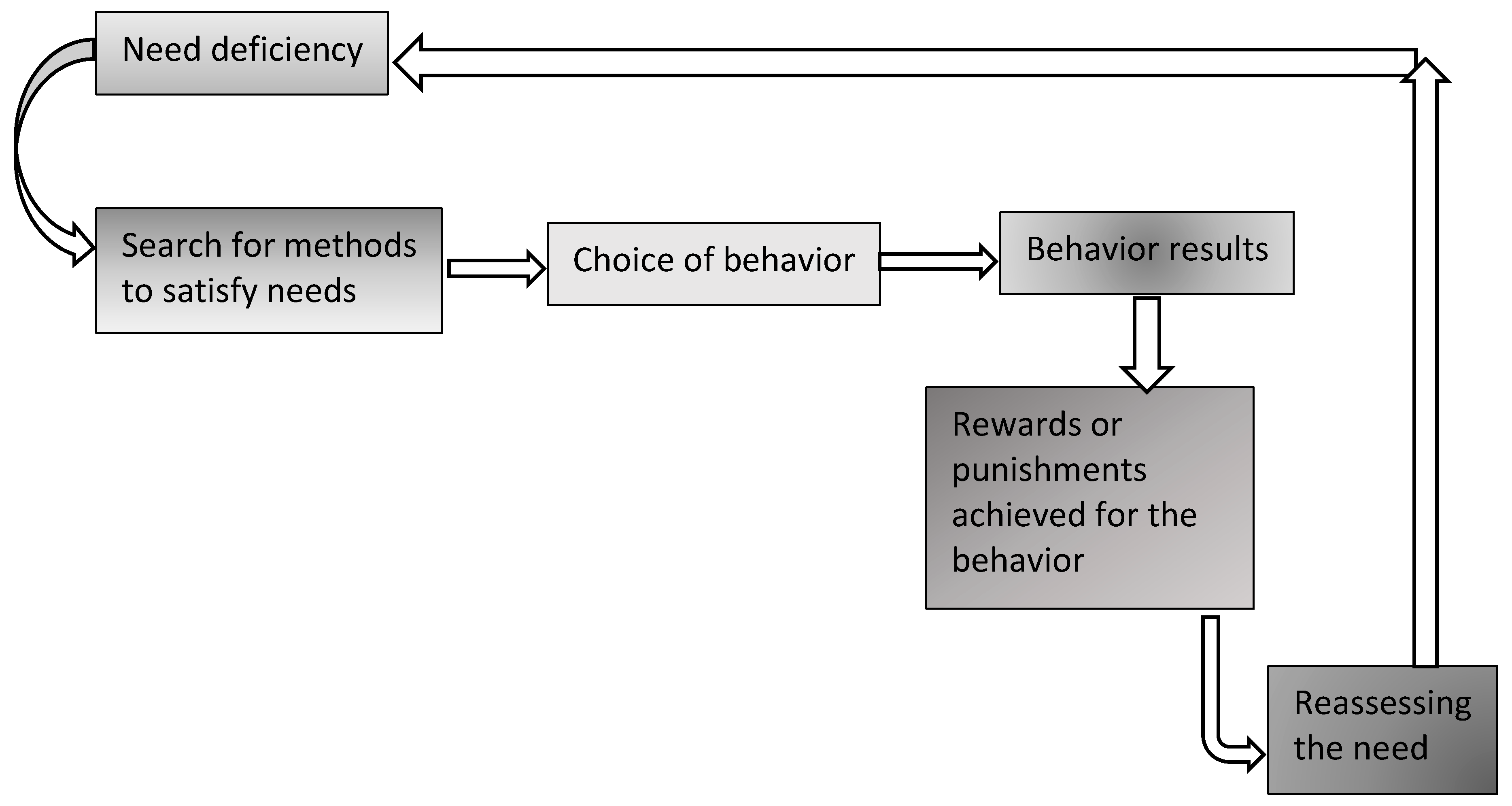
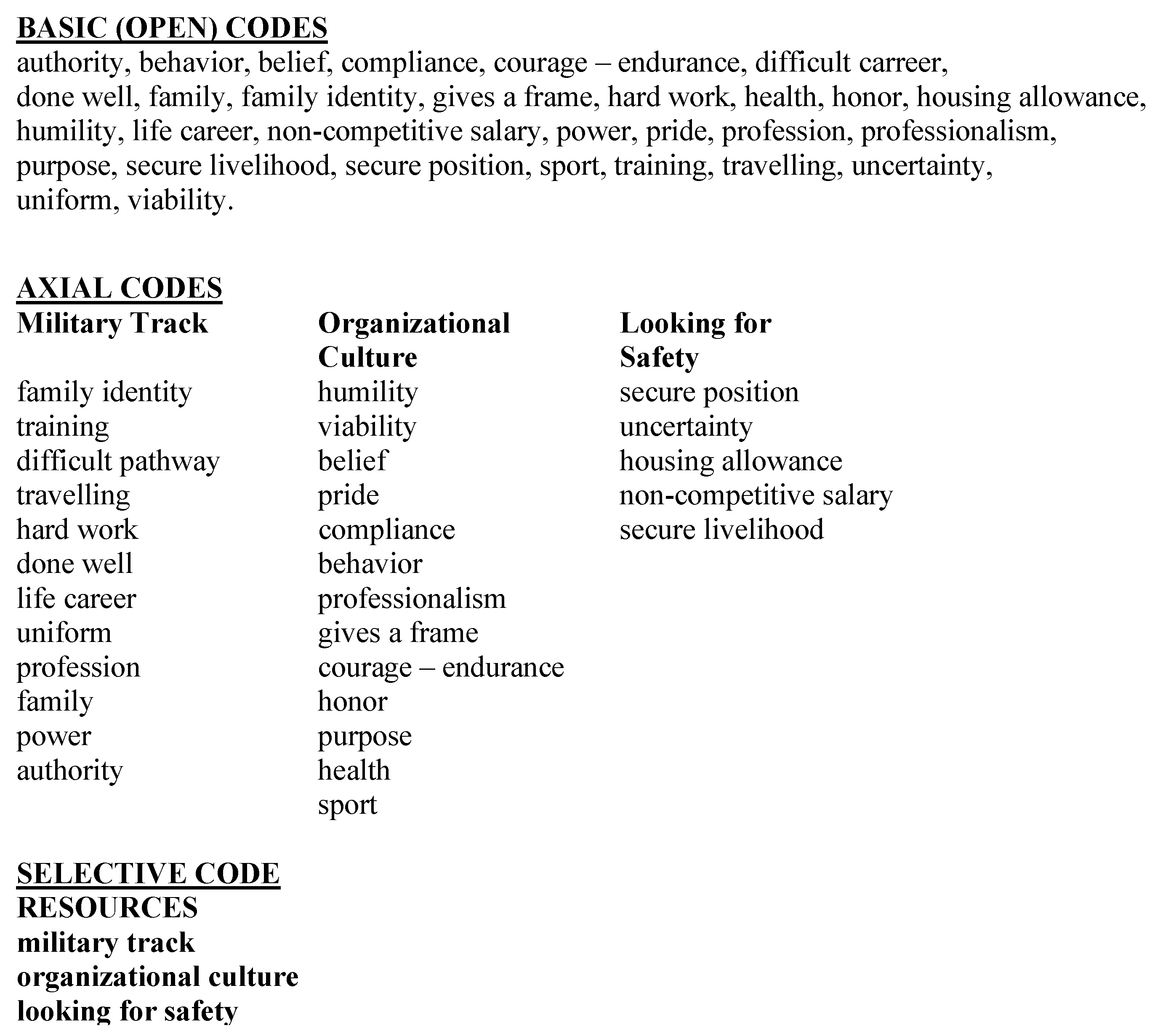
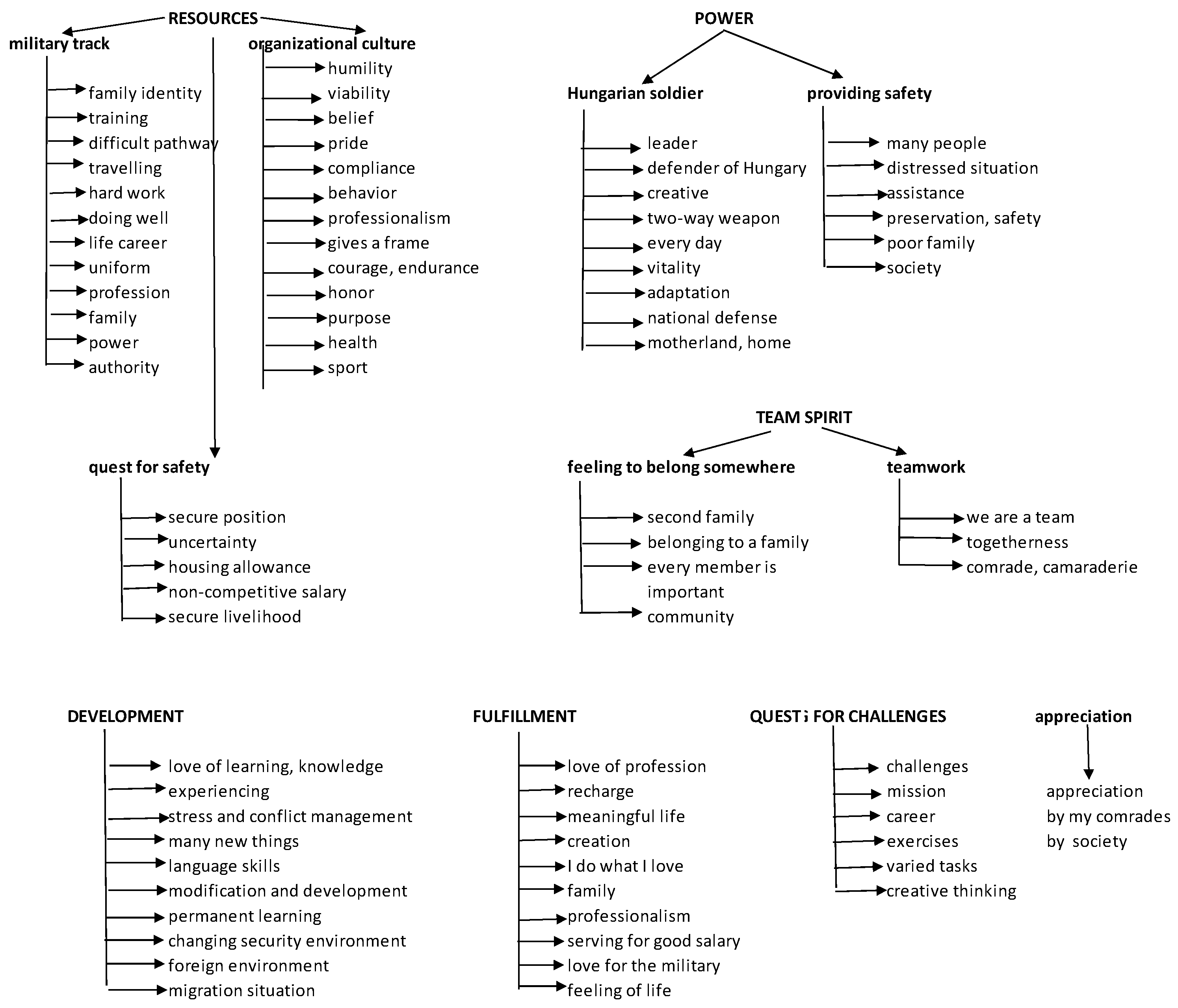
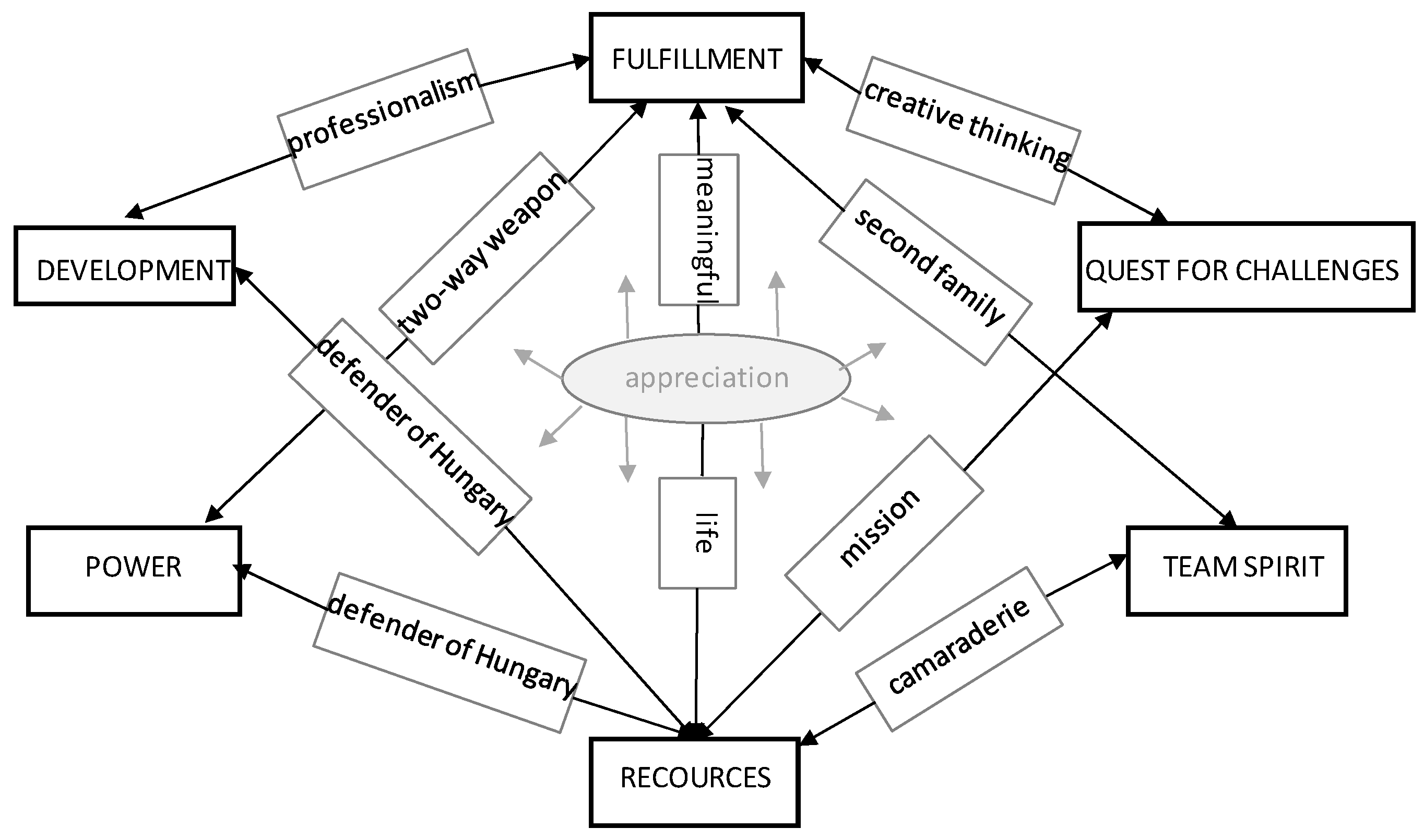
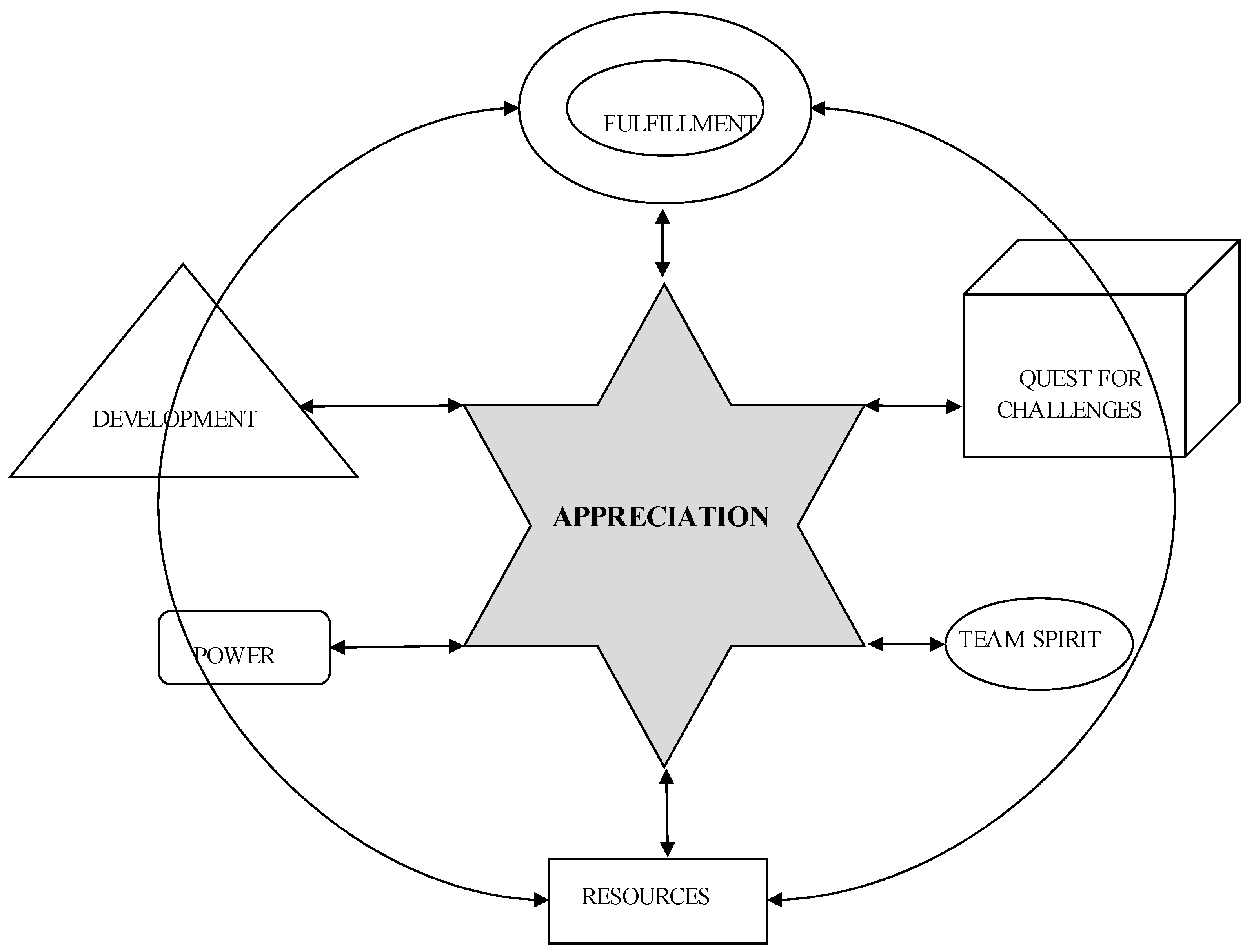
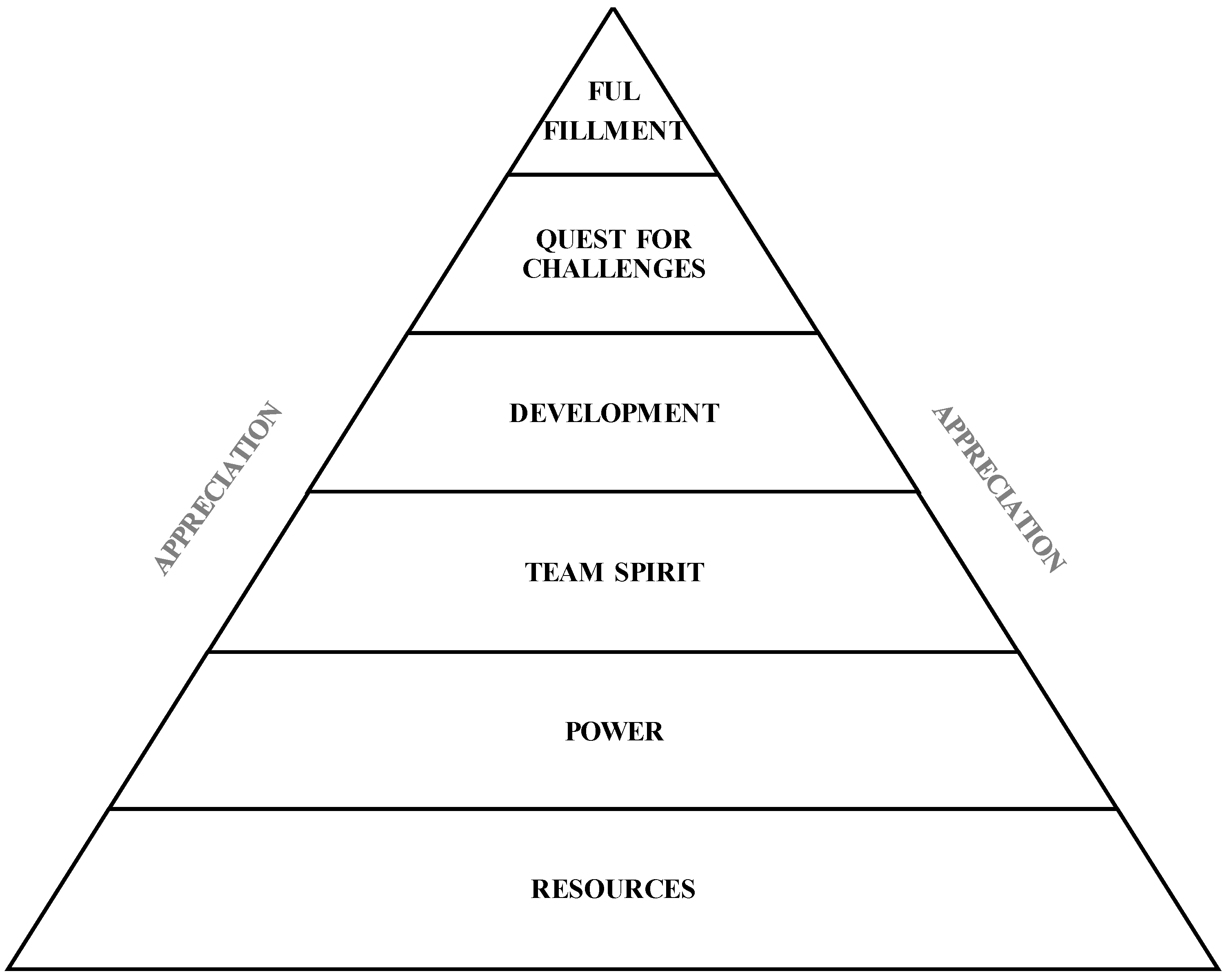
Publisher’s Note: MDPI stays neutral with regard to jurisdictional claims in published maps and institutional affiliations. |
© 2022 by the authors. Licensee MDPI, Basel, Switzerland. This article is an open access article distributed under the terms and conditions of the Creative Commons Attribution (CC BY) license (https://creativecommons.org/licenses/by/4.0/).
Share and Cite
Pákozdi, M.; Bárdos, G. A New Military Hierarchy of Needs Model. Soc. Sci. 2022, 11, 217. https://doi.org/10.3390/socsci11050217
Pákozdi M, Bárdos G. A New Military Hierarchy of Needs Model. Social Sciences. 2022; 11(5):217. https://doi.org/10.3390/socsci11050217
Chicago/Turabian StylePákozdi, Márta, and György Bárdos. 2022. "A New Military Hierarchy of Needs Model" Social Sciences 11, no. 5: 217. https://doi.org/10.3390/socsci11050217
APA StylePákozdi, M., & Bárdos, G. (2022). A New Military Hierarchy of Needs Model. Social Sciences, 11(5), 217. https://doi.org/10.3390/socsci11050217






